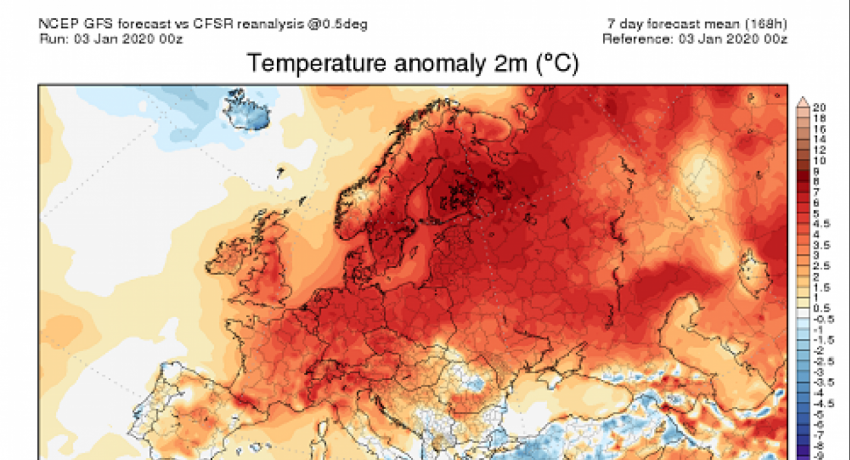The unusual warm temperatures this winter and forecasts indicating milder winter conditions for January, February and March in Europe are partly due to an atmospheric circulation pattern called the North Atlantic Oscillation, or NAO. This atmospheric circulation pattern explains well the weather we get in Europe, especially in winter.
As explained in a CICERO-article from November 2019, seasonal forecast models are sometimes able to correctly forecast the phase of the NAO. 6 different seasonal forecast models are run at the beginning of each month by their respective weather centres from around the globe. The October simulations gave us a hint that we might get a positive phase of the North Atlantic Oscillation for November, December and January. The signal was quite strong, and 4 out of the 6 models were clearly in that direction, while 2 suggested normal winter conditions. The November simulations gave similar results, the majority of the models showed a positive NAO for December, January and February. Experts were a bit puzzled, as at the same time the snow cover over Siberia was already quite extensive, and the Arctic was very warm, two things that usually suggest a cold winter for Europe.
And then came the December simulations, the most recent ones, where all six models hinted to a positive NAO for January, February and March, and therefore milder conditions than normal for northern Europe in particular.
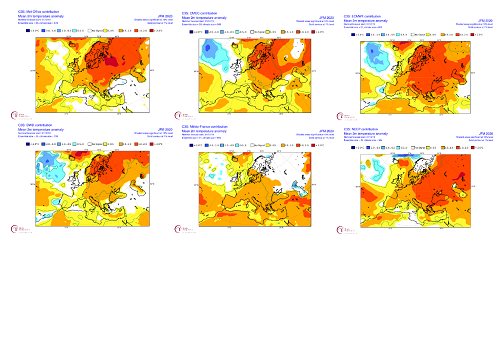
As also explained by colleagues at the research institute Norce, this confirms once more that the models strongly indicate that this winter will be mild until March.
Now that we are in January already, we can look back at the first month of the winter, December. The next figure shows the temperature anomaly for December (it shows by how many degrees that month was warmer or colder compared to the Decembers from 1981-2010).
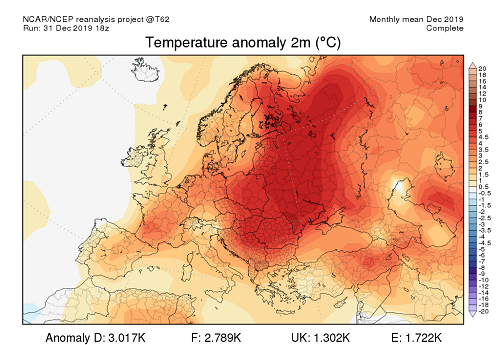
December was milder than usual.
It seems indeed that the models were right, and December was milder than usual. Looking at the forecast for the coming week, this trend seems to continue as well from the weather forecast models:
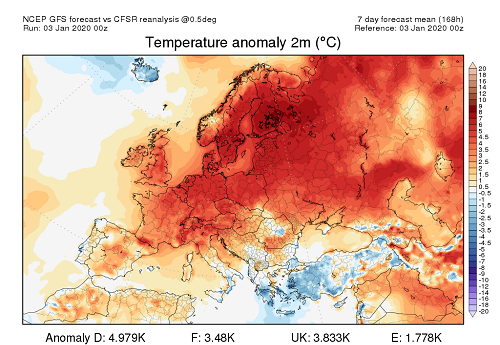
Weather forecast models: The trend seems to continue according to the 7-day forecast from 3 January.
Once the winter is over, seasonal forecast modellers will perform in-depth analyses to understand whether the models were indeed right for the right reasons, because they might also be right just by chance, or even for wrong reasons! But we will have to wait a few months to know that.
Regardless of what happens in the ext months, I believe the winter of 2019/2020 will be considered a very interesting and puzzling season by the scientists, and we will learn a lot from it.
Now to address the question everyone is asking: what is the link with climate change? The answer is not straightforward unfortunately, and again more analyses will be required to provide an answer. But there are a few things that we know:
Warmer winters are expected due to climate change
With climate change, we expect overall warmer winters (and springs, summers and falls), but the key word here is overall, which in climatology means «on average over at least 30 years». This implies that some seasons can still be colder than the reference period (usually 1981-2010). Then, whether a winter (since we are interested in this season) is colder, warmer or average will depend on the atmospheric circulation dominating during that season. This is an intensive area of research at the moment, at the interface between climate and weather. We currently do not understand very well whether some circulation patterns will be more likely in a warmer world, but the consensus regarding the NAO (or AO) is that the oscillation is probably not affected by climate change. For example, the NAO/AO was negative for most of the 2019 spring and summer, and now it is positive. Scientists still expect the NAO/AO to oscillate between positive and negative (and also neutral of course) conditions in the future.
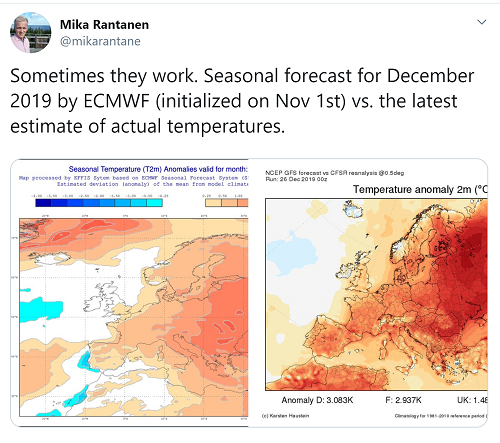
However, since we expect warmer temperatures overall with climate change, and a positive NAO favors warmer (and wetter) conditions over Norther Europe, we might be experiencing mild conditions this winter because of a combination of both processes.
On January 2, 2020, the January temperature record was broken in Sunndalsøra with 19C. This is a new record not only for Norway, but the whole of Scandinavia.
The question everyone is asking is again, was it climate change?
One winter or one extreme weather event cannot be directly linked to Climate change. On a scientific basis, what we can say (and again this will require more analyses), is whether the likelihood of having such a temperature extreme this winter has been increased by climate change. This is similar to smoking cigarettes and lung cancer: some smokers never develop lung cancer, some non-smoker get lung cancer. The only thing medical doctors can say, is that smoking increase the risk of having lung cancer, but other factors like genetics play a role too.
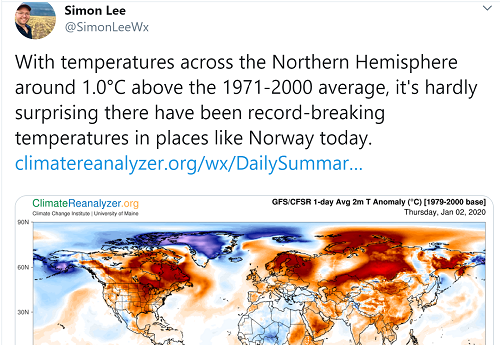
Overwhelming evidence for anthropogenic climate change
We cannot say yet whether it was mostly because of climate change (i.e. the fact that we live in a warmer world) or the particular atmospheric circulation (positive NAO/AO) we are in right now that led to that temperature record. Often, it is the combination of both that leads to extreme events. A single event, be it a heat or cold wave, does not invalidate or confirm climate change. The overwhelming evidence for anthropogenic climate change comes from over 100 years of global temperature records, paleoclimate reconstructions and our physical understanding of the effect of greenhouse gases, to name only but a few.
Written by Nathalie Schaller / CICERO. First published on the CICERO website on 6 January 2020.


